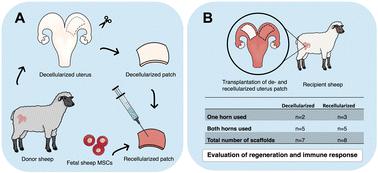当前位置:
X-MOL 学术
›
Biomater. Sci.
›
论文详情
Our official English website, www.x-mol.net, welcomes your feedback! (Note: you will need to create a separate account there.)
Transplantation of a bioengineered tissue patch promotes uterine repair in the sheep
Biomaterials Science ( IF 6.6 ) Pub Date : 2024-03-11 , DOI: 10.1039/d3bm01912h Edina Sehic 1, 2 , Lucía de Miguel Gómez 1, 2 , Hardis Rabe 3, 4 , Emy Thorén 1, 2 , Ingigerdur Gudmundsdottir 1, 2 , Mihai Oltean 1, 5 , Randa Akouri 1, 2 , Mats Brännström 1, 2, 6 , Mats Hellström 1, 2, 3
Biomaterials Science ( IF 6.6 ) Pub Date : 2024-03-11 , DOI: 10.1039/d3bm01912h Edina Sehic 1, 2 , Lucía de Miguel Gómez 1, 2 , Hardis Rabe 3, 4 , Emy Thorén 1, 2 , Ingigerdur Gudmundsdottir 1, 2 , Mihai Oltean 1, 5 , Randa Akouri 1, 2 , Mats Brännström 1, 2, 6 , Mats Hellström 1, 2, 3
Affiliation

|
Innovative bioengineering strategies utilizing extracellular matrix (ECM) based scaffolds derived from decellularized tissue offer new prospects for restoring damaged uterine tissue. Despite successful fertility restoration in small animal models, the translation to larger and more clinically relevant models have not yet been assessed. Thus, our study investigated the feasibility to use a 6 cm2 graft constructed from decellularized sheep uterine tissue, mimicking a future application to repair a uterine defect in women. Some grafts were also recellularized with fetal sheep bone marrow-derived mesenchymal stem cells (SF-MSCs). The animals were followed for six weeks post-surgery during which blood samples were collected to assess the systemic immune cell activation by fluorescence-activated cell sorting (FACS) analysis. Tissue regeneration was assessed by histology, immunohistochemistry, and gene expression analyses. There was a large intra-group variance which prompted us to implement a novel scoring system to comprehensively evaluate the regenerative outcomes. Based on the regenerative score each graft received, we focused our analysis to map potential differences that may have played a role in the success or failure of tissue repair following the transplantation therapy. Notably, three out of 15 grafts exhibited major regeneration that resembled native uterine tissue, and an additional three grafts showed substantial regenerative outcomes. For the better regenerated grafts, it was observed that the systemic T-cell subgroups were significantly different compared with the failing grafts. Hence, our data suggest that the T-cell response play an important role for determining the uterus tissue regeneration outcomes. The remarkable regeneration seen in the best-performing grafts after just six weeks following transplantation provides compelling evidence that decellularized tissue for uterine bioengineering holds great promise for clinically relevant applications.
中文翻译:

生物工程组织补片的移植促进绵羊子宫修复
利用源自脱细胞组织的细胞外基质(ECM)支架的创新生物工程策略为恢复受损子宫组织提供了新的前景。尽管在小动物模型中成功恢复了生育能力,但尚未评估向更大且更具临床相关性的模型的转化。因此,我们的研究调查了使用由脱细胞绵羊子宫组织构建的 6 cm 2移植物的可行性,模拟未来修复女性子宫缺陷的应用。一些移植物还用胎羊骨髓来源的间充质干细胞(SF-MSC)进行再细胞化。手术后对动物进行六周的随访,在此期间收集血液样本,通过荧光激活细胞分选(FACS)分析评估全身免疫细胞的激活情况。通过组织学、免疫组织化学和基因表达分析评估组织再生。组内存在很大的差异,这促使我们实施一种新颖的评分系统来全面评估再生结果。根据每个移植物获得的再生评分,我们集中分析来绘制可能在移植治疗后组织修复的成功或失败中发挥作用的潜在差异。值得注意的是,15 个移植物中的 3 个表现出类似于天然子宫组织的主要再生,另外 3 个移植物显示出显着的再生结果。对于再生较好的移植物,观察到全身 T 细胞亚群与失败的移植物相比显着不同。因此,我们的数据表明 T 细胞反应在确定子宫组织再生结果方面发挥着重要作用。移植后仅六周后,性能最佳的移植物就出现了显着的再生,这提供了令人信服的证据,表明用于子宫生物工程的脱细胞组织在临床相关应用中具有广阔的前景。
更新日期:2024-03-14
中文翻译:

生物工程组织补片的移植促进绵羊子宫修复
利用源自脱细胞组织的细胞外基质(ECM)支架的创新生物工程策略为恢复受损子宫组织提供了新的前景。尽管在小动物模型中成功恢复了生育能力,但尚未评估向更大且更具临床相关性的模型的转化。因此,我们的研究调查了使用由脱细胞绵羊子宫组织构建的 6 cm 2移植物的可行性,模拟未来修复女性子宫缺陷的应用。一些移植物还用胎羊骨髓来源的间充质干细胞(SF-MSC)进行再细胞化。手术后对动物进行六周的随访,在此期间收集血液样本,通过荧光激活细胞分选(FACS)分析评估全身免疫细胞的激活情况。通过组织学、免疫组织化学和基因表达分析评估组织再生。组内存在很大的差异,这促使我们实施一种新颖的评分系统来全面评估再生结果。根据每个移植物获得的再生评分,我们集中分析来绘制可能在移植治疗后组织修复的成功或失败中发挥作用的潜在差异。值得注意的是,15 个移植物中的 3 个表现出类似于天然子宫组织的主要再生,另外 3 个移植物显示出显着的再生结果。对于再生较好的移植物,观察到全身 T 细胞亚群与失败的移植物相比显着不同。因此,我们的数据表明 T 细胞反应在确定子宫组织再生结果方面发挥着重要作用。移植后仅六周后,性能最佳的移植物就出现了显着的再生,这提供了令人信服的证据,表明用于子宫生物工程的脱细胞组织在临床相关应用中具有广阔的前景。



























 京公网安备 11010802027423号
京公网安备 11010802027423号